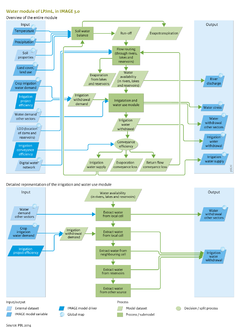Water/Policy issues: Difference between revisions
< Water
Jump to navigation
Jump to search
No edit summary |
Oostenrijr (talk | contribs) m (Text replace - "(Figure" to "(the figure") |
||
| Line 1: | Line 1: | ||
{{ComponentPolicyIssueTemplate | {{ComponentPolicyIssueTemplate | ||
|Reference=Fischer et al., 2005; Molden, 2007; FAO, 2012a; Gerten et al., 2013; Rost et al., 2009; OECD, 2012; | |Reference=Fischer et al., 2005; Molden, 2007; FAO, 2012a; Gerten et al., 2013; Rost et al., 2009; OECD, 2012; | ||
|Description=In baseline scenarios, water use is typically projected to increase rapidly. This can be illustrated in the baseline scenario study for the [[OECD Environmental Outlook to 2050 (2012) project|OECD Environmental Outlook to 2050]] ([[OECD, 2012]]), in which water demand is projected to increase by 53% globally, mostly due to a high increase in non-agricultural water use ( | |Description=In baseline scenarios, water use is typically projected to increase rapidly. This can be illustrated in the baseline scenario study for the [[OECD Environmental Outlook to 2050 (2012) project|OECD Environmental Outlook to 2050]] ([[OECD, 2012]]), in which water demand is projected to increase by 53% globally, mostly due to a high increase in non-agricultural water use (the figure below). However, this baseline scenario did not consider irrigated area expansion, which is expected to further increase demand for irrigation water (the figure below top left). As a result of the increase in total water demand, and a change in water availability due to climate change, the number of people living in medium to severely water stressed basins will increase by 80%, according to this baseline (the figure below top right). | ||
Expansion of rain-fed and irrigated croplands together with increased crop yields are projected in studies on the future of the global food system ([[Fischer et al., 2005]]; [[Molden, 2007]]; [[FAO, 2012a]]; [[Gerten et al., 2013]]). However, irrigation expansion and related increases in crop yields may not be feasible because of water scarcity ( | Expansion of rain-fed and irrigated croplands together with increased crop yields are projected in studies on the future of the global food system ([[Fischer et al., 2005]]; [[Molden, 2007]]; [[FAO, 2012a]]; [[Gerten et al., 2013]]). However, irrigation expansion and related increases in crop yields may not be feasible because of water scarcity (the figure below bottom). | ||
|Example=Several water-related policy interventions can be assessed with IMAGE-LPJmL, including improved rainwater management, improved irrigation efficiency, increasing storage capacity and land-use related interventions. For example, Rost et al. ([[Rost et al., 2009|2009]]) evaluated the effect of improved rainwater management on crop production by decreasing soil evaporation and increasing rainwater harvesting. Biemans et al. ([[Biemans, 2012|2012]]) tested the effect of improved irrigation efficiency and expansion of storage capacity on irrigation water demand and available sources of supply for five river basins on the Indian subcontinent ( | |Example=Several water-related policy interventions can be assessed with IMAGE-LPJmL, including improved rainwater management, improved irrigation efficiency, increasing storage capacity and land-use related interventions. For example, Rost et al. ([[Rost et al., 2009|2009]]) evaluated the effect of improved rainwater management on crop production by decreasing soil evaporation and increasing rainwater harvesting. Biemans et al. ([[Biemans, 2012|2012]]) tested the effect of improved irrigation efficiency and expansion of storage capacity on irrigation water demand and available sources of supply for five river basins on the Indian subcontinent (the figure below). | ||
In combination with the crop model, the effect of land-use related policy interventions could be addressed, such as changes in crop types or improved land and water allocation. | In combination with the crop model, the effect of land-use related policy interventions could be addressed, such as changes in crop types or improved land and water allocation. | ||
}} | }} | ||
Revision as of 11:51, 24 June 2014
Parts of Water/Policy issues
| Component is implemented in: |
|
| Related IMAGE components |
| Projects/Applications |
| Key publications |
| References |
